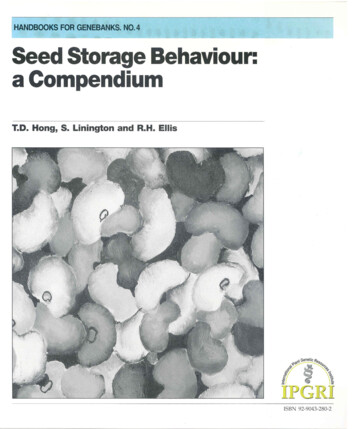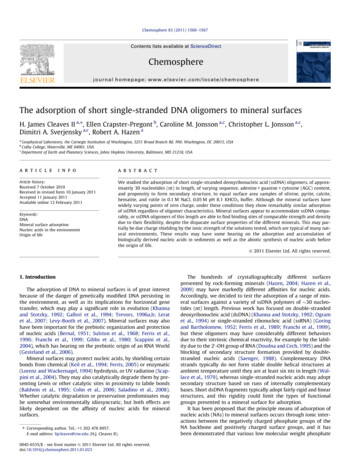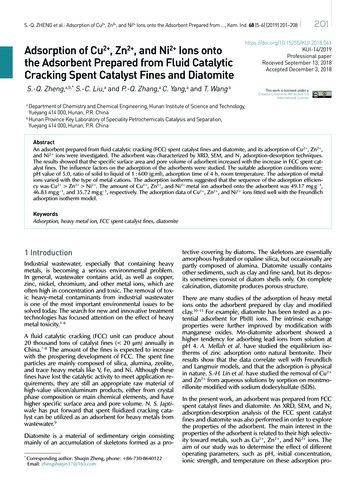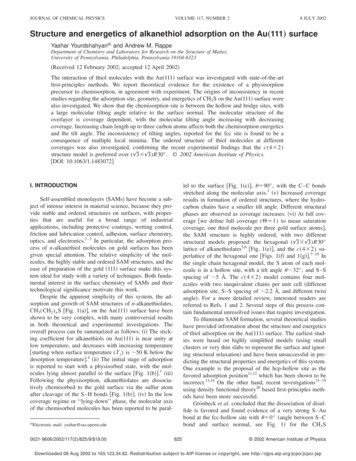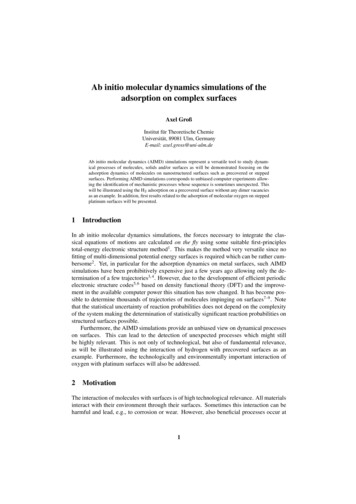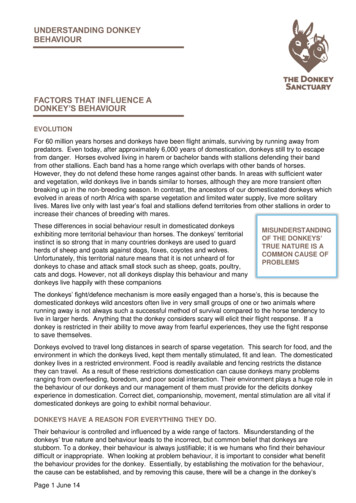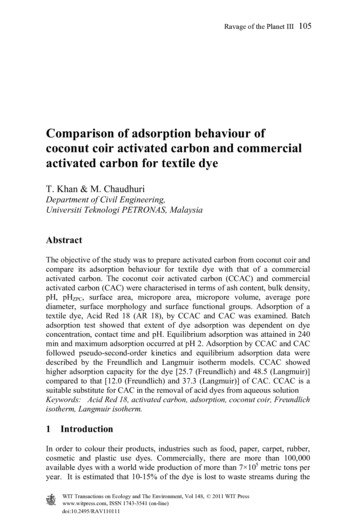
Transcription
Ravage of the Planet III105Comparison of adsorption behaviour ofcoconut coir activated carbon and commercialactivated carbon for textile dyeT. Khan & M. ChaudhuriDepartment of Civil Engineering,Universiti Teknologi PETRONAS, MalaysiaAbstractThe objective of the study was to prepare activated carbon from coconut coir andcompare its adsorption behaviour for textile dye with that of a commercialactivated carbon. The coconut coir activated carbon (CCAC) and commercialactivated carbon (CAC) were characterised in terms of ash content, bulk density,pH, pHZPC, surface area, micropore area, micropore volume, average porediameter, surface morphology and surface functional groups. Adsorption of atextile dye, Acid Red 18 (AR 18), by CCAC and CAC was examined. Batchadsorption test showed that extent of dye adsorption was dependent on dyeconcentration, contact time and pH. Equilibrium adsorption was attained in 240min and maximum adsorption occurred at pH 2. Adsorption by CCAC and CACfollowed pseudo-second-order kinetics and equilibrium adsorption data weredescribed by the Freundlich and Langmuir isotherm models. CCAC showedhigher adsorption capacity for the dye [25.7 (Freundlich) and 48.5 (Langmuir)]compared to that [12.0 (Freundlich) and 37.3 (Langmuir)] of CAC. CCAC is asuitable substitute for CAC in the removal of acid dyes from aqueous solutionKeywords: Acid Red 18, activated carbon, adsorption, coconut coir, Freundlichisotherm, Langmuir isotherm.1 IntroductionIn order to colour their products, industries such as food, paper, carpet, rubber,cosmetic and plastic use dyes. Commercially, there are more than 100,000available dyes with a world wide production of more than 7 105 metric tons peryear. It is estimated that 10-15% of the dye is lost to waste streams during theWIT Transactions on Ecology and The Environment, Vol 148, 2011 WIT Presswww.witpress.com, ISSN 1743-3541 (on-line)doi:10.2495/RAV110111
106 Ravage of the Planet IIIdyeing process in the textile industry [1, 2]. Due to synthetic origin and complexaromatic molecular structure, dyes are more stable and difficult to biodegrade[3]. Dyes can accumulate in sediment and soil at locations of wastewaterdischarge, and due to leaching from the soil groundwater systems are alsoaffected [4]. Some dyes are mutagenic and carcinogenic and can cause severedamage to humans such as dysfunction of the kidney, reproductive system, liver,brain and central nervous system [5].Dye waste treatment has been the target of concern not only because of thetoxicity of the dyes but also due to their visibility [6]. Treatment methods such aschemical oxidation, ion exchange, evaporation, reverse osmosis and chemicalprecipitation have the disadvantages of high capital and operational cost anddisposal of the residual sludge [7]. Adsorption by activated carbon is a promisingtechnique for dye waste treatment. However, use of coal-based commercialactivated carbon is limited because of its relatively high price and its feedstock isnonrenewable. Low-cost, renewable, and easily available plant-based materialsneed to be used as a source in the production of activated carbon.In recent years, plant-based material such as silk cotton hull, coconut treesawdust, banana pith, maize cob and sago waste [5] corncob wastes [8], coir pith[9], sawdust [10], rice husk [11], bagasse [12, 13], peach stone [14], seed shell[15] and sunflower seed hull [16] have been used as sources in the production ofactivated carbon for the treatment of textile dye waste. Coconut coir is anagricultural solid waste. In Malaysia, coconut is the fourth most importantindustrial crop in terms of total planted area. Coconut coir is available free ofcost in large quantities from the coconut oil and desiccated product industry.Preparation of activated carbon from this agricultural solid waste would not onlybe economical but also solve part of solid waste disposal problem.In this study, activated carbon was prepared from coconut coir and adsorptionof a textile dye, Acid Red 18 (AR 18), from aqueous solution by the coconut coiractivated carbon and a commercial activated carbon was examined.2 Materials and methods2.1 Preparation of activated carbonCoconut coir activated carbon (CCAC) was prepared according to a method usedby Santhy and Selvapathy [9] for preparing coir pith activated carbon. Washedand dried coconut coir was treated with concentrated sulphuric acid and kept in ahot-air oven at 105 5 C for 24 h. Thereafter, the char was washed with waterfollowed by washing with 2% sodium bicarbonate solution until effervescencehad ceased and then kept in a 2% sodium bicarbonate solution overnight. Thechar was separated and washed with water until free from bicarbonate and driedat 105 5 C for 24 h. It was then subjected to activation at 900 C for 30 min inan atmosphere of nitrogen. The activated carbon obtained was repeatedly washedwith distilled water and soaked in 10% hydrochloric acid to remove calciumoxide, followed by repeated washing with water to remove free acid and dryingWIT Transactions on Ecology and The Environment, Vol 148, 2011 WIT Presswww.witpress.com, ISSN 1743-3541 (on-line)
Ravage of the Planet III107at 105 5 C for 24 h. The CCAC was ground to a size of 200-500 µm and used inadsorption test.A commercial activated carbon (CAC) was obtained from the Calgon CarbonCorporation, Pittsburgh, PA. It was ground to a size of 200-500 µm and used inadsorption tests.2.2 Textile dyeA textile dye, Acid Red 18 (AR 18) was obtained in powdered form from EuroChemo-Pharma Sdn. Bhd., Prai Industrial Estate, Penang, Malaysia.2.3 Adsorption testBatch adsorption test was carried out by shaking 100 mL of dye solution ofdesired concentration with 2 g/L of activated carbon in a conical flask at roomtemperature (22 C) using an orbital shaker at 150 rpm. After a predeterminedcontact time, the flask was removed from the orbital shaker and the supernatantwas filtered through 0.45 μm membrane filter, and the residual dye concentrationwas determined spectrophotometrically by measuring the absorbance at thewavelength of maximum absorbance (508 nm) against a standard curve. Theeffect of contact time (15–300 min), dye concentration (40–100 mg/L), pH (2–8)and carbon dosage (1–8 g/L) on adsorption were determined. The adsorptionisotherms for CCAC and CAC were determined by batch equilibrium test usingthe optimum contact time and pH for dye adsorption by the activated carbons.3 Results and discussion3.1 Characterisation of activated carbonVarious physical and chemical characteristics of CCAC and CAC are listed intable 1. CCAC possesses higher surface and micropore area, micropore volumeand average pore diameter, and lower pHZPC and pH than those of CAC.Table 1:Physical and chemical characteristics of CCAC and CAC.ParameterSurface area (m2/g)Micropore area (m2/g)Micropore volume (mL/g)Average pore diameter (Å)Ash content (%)Bulk density 0.2315.35220.527.25.63.2 Scanning electron micrographScanning electron micrographs of CCAC and CAC at 200X magnification areshown in fig. 1. CCAC contains more macro- and micropores than the CAC.WIT Transactions on Ecology and The Environment, Vol 148, 2011 WIT Presswww.witpress.com, ISSN 1743-3541 (on-line)
108 Ravage of the Planet III(A)Figure 1:(B)Scanning electron micrograph of (A) CCAC and (B) CAC.3.3 Fourier transform infrared (FTIR) spectroscopyThe FTIR spectra recorded in the region of 500-4000 cm-1 for CCAC and CACare shown in fig. 2. The band at 3407 cm-1 corresponds to stretching vibration ofOH . Two weak bands at 2923-2852 cm-1 and at 2921-2850 cm-1 for CCAC andCAC, respectively indicate aliphatic group stretching vibration [17]. Largepeaks observed at 2360 cm-1 and 2341 cm-1 for CCAC and CAC, respectivelyindicate antisymmetric stretching of CO2[18]. The peaks observed atapproximately 1658 cm-1 and 1656 cm-1 for CCAC and CAC, respectively canbe assigned to symmetric and asymmetric stretching vibration of C C group.The peaks at 1581 cm-1 and 1571 cm-1 for CCAC and CAC, respectively are dueto aromatic rings of C C. The intensity for CCAC was found to be greater thanCAC at the peak 1402 cm-1, indicating the presence of pyrones and aromaticgroups in CCAC. The small peaks in the region of 1100-1200 cm-1 for bothTransmittance, %BA4000350030002500200015001000-1Wavenumber, cmFigure 2:FTIR spectra of (A) CCAC and (B) CAC.WIT Transactions on Ecology and The Environment, Vol 148, 2011 WIT Presswww.witpress.com, ISSN 1743-3541 (on-line)500
Ravage of the Planet III109CCAC and CAC can be assigned to the C-O stretching vibrations of carboxylicand phenolic groups [19]. The peaks in the region of 700-610 cm-1 are due tosymmetric and asymmetric stretching of SO2 and symmetric stretching vibrationof S-O groups, confirming the presence of surface SO2 complexes [17] in bothCCAC and CAC.3.4 Adsorption test3.4.1 Effect of contact time and dye concentration on adsorptionThe effect of contact time and dye concentration on adsorption of AR 18 byCCAC is shown in fig. 3. The extent of dye adsorption increased as the initialdye concentration decreased and as the contact time increased. Equilibriumadsorption was attained in 240 min. Similar equilibrium contact time of 240 minalso has been reported by Thinakaran et al. [15] for the adsorption of Acid Red114 from aqueous solution using activated carbons prepared from seed shells.10090Adsorption, %8070605040 mg/L4060 mg/L3080 mg/L20100 mg/L1000153060120180240300330Contact time, minFigure 3:Effect of contact time and dye concentration on adsorption of AR18 by CCAC.3.4.2 Effect of pH on dye adsorptionThe effect of pH on the adsorption of AR 18 by CCAC was studied by varyingthe pH of the dye solution in the range 2-8, with 2 g/L carbon dose and initialdye concentration of 80 mg/L, fig. 4. It is observed that maximum adsorption(91%) occurred at acidic pH 2. Similar observation has been reported byThinakaran et al. [16] for adsorption of Acid Violet 17 by activated carbonprepared from sunflower seed hull. As the pHZPC of CCAC is 5.3, the positivesurface charge on the carbon surface increases in the acidic pH range and thiswould attract the negatively charged functional groups on the dye. pH 2 wasselected as optimum pH value for adsorption and all subsequent adsorption testswere conducted at pH 2.WIT Transactions on Ecology and The Environment, Vol 148, 2011 WIT Presswww.witpress.com, ISSN 1743-3541 (on-line)
110 Ravage of the Planet III100Adsorption, %806040200023456789pHFigure 4:Effect of pH on adsorption of AR 18 by CCAC.3.4.3 Effect of carbon dose on dye adsorptionAdsorption of AR 18 by CCAC from a 120 mg/L dye solution was studied byvarying the carbon dose over a range of 1–8 g/L, employing a pH of 2 and acontact time of 240 min. As shown in fig. 5, the maximum adsorption (99.5%)occurred at 4 g/L of carbon dose.120Adsorption, %10080604020001246810Carbon dose, g/LFigure 5:Effect of carbon dose on adsorption of AR 18 by CCAC.3.5 Adsorption isothermIn adsorption in a solid-liquid system, the distribution ratio of the solute betweenthe liquid and the solid phase is a measure of the position of equilibrium. Thepreferred form of depicting this distribution is to express the quantity qe as aWIT Transactions on Ecology and The Environment, Vol 148, 2011 WIT Presswww.witpress.com, ISSN 1743-3541 (on-line)
Ravage of the Planet III111function of Ce at a fixed temperature, the quantity qe being the amount of soluteadsorbed per unit weight of the solid adsorbent, and Ce the concentration ofsolute remaining in the solution at equilibrium. An expression of this type istermed an adsorption isotherm [20].The Langmuir adsorption isotherm isqe Q o bC e1 bC e(1)where, Q is the amount of solute adsorbed per unit weight of adsorbent informing a monolayer on the surface (monolayer adsorption capacity) and b is aconstant related to the energy of adsorption.The Freundlich adsorption isotherm isqe K f C e1 / n(2)where, Kf is the Freundlich constant (adsorption capacity) and 1/n represents theadsorption intensity or surface heterogeneity.Adsorption isotherms for AR 18 onto CCAC and CAC were determined bybatch equilibrium test employing the optimum contact time 240 min andoptimum pH 2 for both activated carbons. The isotherm data were fitted to thelinear forms of the Langmuir equation, fig. 6 and the Freundlich equation, fig. 7,and values of the constants were determined, Table 2. The values of Qº and Kfindicate that CCAC exhibited higher adsorption capacity for AR 18 than CAC.1.81.61.4y 0.0268x 0.1954Ce/qe1.2R2 0.951710.80.6CACCCAC0.4y 0.0206x 0.01612R 0.9820.200510152025303540455055CeFigure 6:Langmuir adsorption isotherm of AR 18 adsorption.WIT Transactions on Ecology and The Environment, Vol 148, 2011 WIT Presswww.witpress.com, ISSN 1743-3541 (on-line)60
112 Ravage of the Planet IIITable 2:Langmuir and Freundlich constants for AR 18 adsorption by CCACand CAC.ActivatedcarbonLangmuir isotherm constant CCACCACFreundlich isotherm constantQ (mg/g)b (L/g)Kf1/n48.537.31.270.1325.712.00.20.22y 0.2162x 1.4112R 0.9913log qe1.5y 0.2499x 1.07952R 0.8451CACCCAC0.5000.30.60.91.21.51.82.1log CeFigure 7:Freundlich adsorption isotherm of AR 18 adsorption.3.6 Adsorption kineticsA kinetic study for adsorption of AR 18 by CCAC and CAC was carried out byusing two models i.e. the pseudo-first-order and pseudo-second-order.The linear form of the pseudo-first-order model isk1t2.303The linear form of the pseudo-second-order model islog(qe qt ) log qe (3) t 1 t (4) qt k 2 qe2 qe where, qe and qt are the amounts of dye adsorbed (mg/g) at equilibrium and anytime t, respectively; k1 is the equilibrium rate constant of pseudo-first-orderkinetics (min-1); and k2 is the equilibrium rate constant of pseudo-second-orderkinetics (g/mg·min).WIT Transactions on Ecology and The Environment, Vol 148, 2011 WIT Presswww.witpress.com, ISSN 1743-3541 (on-line)
Ravage of the Planet III113Plots of log (qe – qt) versus t and of t/qt versus t are presented in fig. 8 and 9,respectively, while table 3 lists the values of k1, k2, qe and R2 for the two models.Comparatively higher values of R2 for the pseudo-second-order kinetic modelthan those for the pseudo-first-order kinetic model, and the close values of qe,calc and qe, exp indicate that the pseudo-second-order kinetic model gave betterfit to the experimental data for both activated carbons. Similar observations havebeen reported for the adsorption of Acid Violet 17 onto activated carbonprepared from sunflower seed hull [16] and acid dyes onto activated carboncloth [21].1.61.21.41log (qe-qt)log (qe-qt)1.210.8140 mg/L160 mg/L180 mg/L200 mg/L0.60.40.20.80.6140 mg/L160 mg/L180 mg/L200 ure 8:180210240(B)Pseudo-first-order kinetics of AR 18 adsorption by (A) CCAC and(B) CAC.10897867t/qt, min. g/mgt/qt, min. g/mg150t, mint, min5414016018020032mg/Lmg/Lmg/Lmg/L65140 mg/L160 mg/L180 mg/L200 mg/L432110003060901201501802102402700306090120t, min(A)Figure 9:150180210240270t, min(B)Pseudo-second-order kinetics of AR 18 adsorption by (A) CCACand (B) CAC.4 ConclusionsThe adsorption capacity of coconut coir activated carbon for Acid Red 18 washigher than that of a commercial activated carbon, with the adsorption kineticsfor both activated carbons following the pseudo-second-order model. Coconutcoir activated carbon is a suitable substitute for commercial activated carbon inthe adsorption of acid dyes from aqueous solution.WIT Transactions on Ecology and The Environment, Vol 148, 2011 WIT Presswww.witpress.com, ISSN 1743-3541 (on-line)
114 Ravage of the Planet IIITable 3:Pseudo-first-order and pseudo-second-order kinetic rate constantsand experimental and calculated qe values of AR 18 adsorption byCCAC and CAC.Activatedcarbon andinitial dyeconcentrationCCACqe, exp(mg/g)Pseudo-first order model140 mg/L160 mg/L180 mg/L200 60.99440.99360.98090.9853140 mg/L160 mg/L180 mg/L200 99040.99570.99740.9996-3-1k1 10 (min ) qe, cal (mg/g) R2Pseudo-second-order model2k 10-3 (g/mg min) qe, cal (mg/g) R2AcknowledgementsThe authors are thankful to the management and authorities of the UniversitiTeknologi PETRONAS (UTP) and the Civil Engineering Department, UTP forproviding facilities for this research.References[1] Al-Ghouti, M.A., Khraisheh, M.A.M., Allen, S.J. & Ahmed, M.N., Theremoval of dyes from textile wastewater: a study of the physicalcharacteristics and adsorption mechanisms of diatomaceous earth. Journalof Environmental Management, 69 (3), pp. 229-238, 2003.[2] Pearce, C.I., Lloyd, J.R. & Guthrie, J.T., The removal of colour from textilewastewater using whole bacterial cells: a review. Dyes and Pigments, 58(3), pp. 179-196, 2003.[3] Eren, Z. & Acar, F.N., Adsorption of Reactive Black 5 from an aqueoussolution: Equilibrium and kinetic studies. Desalination, 194 (1-3), pp. 1-10,2006.[4] Namasivayam, C. & Sumithra, S., Removal of Direct Red 12B andMethylene Blue from water by adsorption onto Fe(III)/Cr(III) hydroxide, anindustrial solid waste. Journal of Environmental Management, 74 (3),pp. 207-215, 2005.[5] Kardievelu, K., Kavipriya, M., Karthica, C., Radhika, M., Vennilamani, N.& Pattabhi, S., Utilization of various agricultural wastes for activatedcarbon preparation and application for the removal of dyes and metal ionsfrom aqueous solutions. Bioresource Technology, 87 (1), pp. 129-132,2003.[6] Aksu, Z. & Tezer, S., Biosorption of reactive dyes on the green algaChlorella vulgaris. Process Biochemistry, 40 (3-4), pp. 1347-1361, 2005.WIT Transactions on Ecology and The Environment, Vol 148, 2011 WIT Presswww.witpress.com, ISSN 1743-3541 (on-line)
Ravage of the Planet III115[7] Sharma, D.C. & Forester, C.F., A preliminary examination into theadsorption of hexavalent chromium using low-cost adsorbents. BioresourceTechnology, 47 (3), pp. 257-264, 1994.[8] Wu, F.C., Tseng, R.L. & Juang, R.S., Adsorption of dyes and phenols fromwater on the activated carbons prepared from corncob wastes.Environmental Technology, 22 (2), pp. 205-213, 2001.[9] Santhy, K. & Selvapathy, P., Removal of reactive dyes from wastewater byadsorption on coir pith activated carbon. Bioresource Technology, 97 (11),pp. 1329-1336, 2006.[10] Garg, V.K., Amita, M., Kumar, R. & Gupta, R., Basic dye (methylene blue)removal from simulated wastewater by adsorption using Indian rosewoodsawdust: A timber industry waste. Dyes and Pigments, 63 (3), pp. 243-250,2004.[11] Guo, Y., Yang, S., Fu, W., Qi, J., Li, R., Wang, Z. & Xu H., Adsorption ofmalachite green on micro- and mesoporous rice husk-based active carbon.Dyes and Pigments, 56 (3), pp. 219-229, 2003.[12] Juang, R.S., Wu, F.C. & Tseng, R.L., Characterization and use of activatedcarbons prepared from bagasse for liquid-phase adsorption. Colloids andSurfaces A, 201 (1-3), pp. 191-199, 2002.[13] Valix, M., Cheung, W.H. & McKay, G., Preparation of activated carbonusing low temperature carbonisation and physical activation of high ashraw bagasse for acid dye adsorption, Chemosphere, 56 (5), pp. 493-501,2004.[14] Gercel, O., Ozcan, A., Ozcan, A.S. & Gercel, H.F., Capacity of activatedcarbon derived from peach stones by K2CO3 in the removal of acid, reactiveand direct dyes from aqueous solution. Journal of EnvironmentalEngineering, 135 (5), pp. 333-340, 2009.[15] Thinakaran, N., Panneerselvam, P., Baskaralingam, P., Elango D. &Sivanesan, S., Equilibrium and kinetic studies on the removal of acid red114 from aqueous solutions using activated carbons prepared from seedshells. Journal of Hazardous Materials, 158 (1), pp. 142-150, 2008.[16] Thinakaran, N., Baskaralingam, P., Pulikesi, M., Panneerselvam, P. &Sivanesan, S., Removal of Acid Violet 17 from aqueous solution byadsorption onto activated carbon prepared from sunflower seed hul. Journalof Hazardous Materials, 151 (2-3), pp. 316-322, 2008.[17] Gercel, O., Ozcan, A., Ozcan, A.S. & Gercel, H.F., Preparation of activatedcarbon from a renewable bio-plant of Euphorbia rigida by H2SO4activation and its adsorption behavior in aqueous solutions. Applied SurfaceScience, 253 (11), pp. 4843-4852, 2007.[18] Shu, W.M., Hira, S.O., Suzuki, T. & Nishi M.F., Radiochemical reactionsbetween tritium oxides and carbon monoxide. Fusion Engineering andDesign, 70 (2), pp.123-129, 2004.[19] Sricharoenchaikul, V., Pechyen, C., Aht-Ong, D. & Atong, D., Preparationand characterization of activated carbon from the pyrolysis of physic nut(Jatropha curcas L.) waste. Energy and Fuels, 22 (1), pp. 31-37, 2008.WIT Transactions on Ecology and The Environment, Vol 148, 2011 WIT Presswww.witpress.com, ISSN 1743-3541 (on-line)
116 Ravage of the Planet III[20] Weber W.J., Jr., Adsorption (Chapter 5). Physicochemical Processes forWater Quality Control, ed. W.J. Weber, Jr., Wiley–Interscience: New York,pp. 199-259, 1972.[21] Hoda, N., Bayram, E. & Ayranci, E., Kinetic and equilibrium studies on theremoval of acid dyes from aqueous solutions by adsorption onto activatedcarbon cloth. Journal of Hazardous Materials, 137 (1), pp. 344-351, 2006.WIT Transactions on Ecology and The Environment, Vol 148, 2011 WIT Presswww.witpress.com, ISSN 1743-3541 (on-line)
Chemo-Pharma Sdn. Bhd., Prai Industrial Estate, Penang, Malaysia. 2.3 Adsorption test Batch adsorption test was carried out by shaking 100 mL of dye solution of desired concentration with 2 g/L of activated carbon in a conical flask at room temperature (22 C) using an orbital shaker at 150 rpm. After a predetermined

